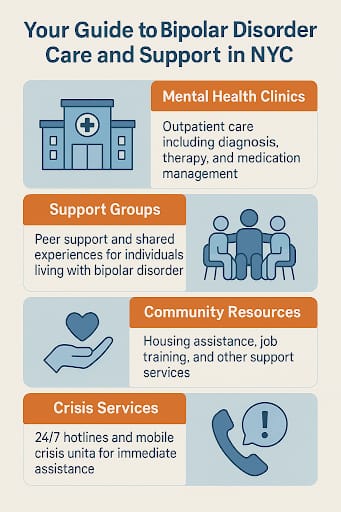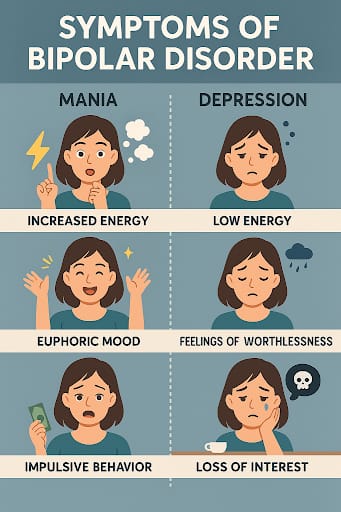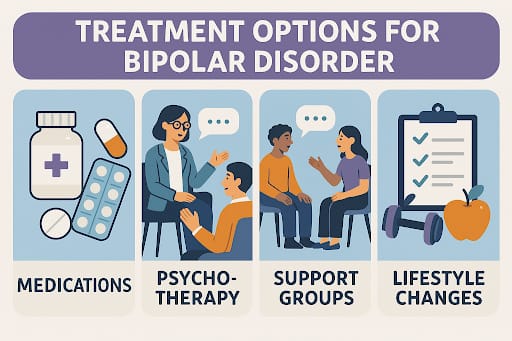
INTRODUCTION
Bipolar disorder can feel like being stuck between two extremes of emotion, where one moment you are riding high on euphoric energy and the next moment you are drowning in despair. Bipolar disorder affects millions of people across the globe, and is one of the most treatable mental health challenges, with proper treatment, care, support and lifestyle adaptations.
This blog will provide a comprehensive overview to understanding bipolar disorder, treatments available to tackle it, coping mechanisms, finding support, and how to learn to live your best life with acceptance and empowerment.
What Is Bipolar Disorder?
Bipolar disorder, previously known as manic depressive illness and chronic mental health condition characterized by extreme fluctuations in mood, energy, thinking, and behavior. These mood changes can last anywhere from hours to months and often disrupt daily functioning.
Bipolar disorder (BD) consists of repeated episodes of mania or hypomania and episodes of depression over a lifetime, and almost always is not diagnosed appropriately in the early stages. The bipolar and related disorders category includes: bipolar I disorder (BD-I), bipolar II disorder (BD-II), cyclothymic disorder, other specified bipolar and related disorders and unspecified bipolar or related disorders.
The International Classification of Diseases 10th Revision (ICD-10) referred to these conditions as “bipolar affective disorders,” but has changed this nomenclature to “bipolar disorders” in the ICD-11. The ICD-11 section is titled “bipolar and related disorders”, which is the same terminology as the Diagnostic and Statistical Manual of Mental Disorders (5th edition) (DSM-5).
An estimate by the World Health Organization, showing that the international rates of prevalence, severity, impact, and co-occurring conditions of the bipolar spectrum disorders (BD-I, BD-II, and subthreshold bipolar) are remarkably similar across countries. The combined lifetime prevalence of bipolar spectrum disorders is estimated at 2.4%.
Types of Bipolar Disorder
The various types of bipolar disorder can have unique features.
- Bipolar I disorder involves one or more manic episodes that can last at least seven days or, if severe, can result in hospitalization. Patients may also experience depressive episodes that can last at least two weeks.
- Bipolar II disorder is when a patient will experience one or more depressive episodes that occur with hypomanic episodes. Patients with hypomania experience less severe symptoms than full mania as seen in Bipolar I disorder.
- Cyclothymic disorder, or cyclothymia, consists of periods of hypomanic and depressive symptoms lasting at least two years in adults (one year for children and adolescents); however, the symptoms do not meet the criteria for a hypomanic disorder or a depressive episode.
There also can be types of bipolar not fitting the types described above, such as those with mood changes due to some drug(s) or being caused by a specific medical condition.
Symptoms of Bipolar Disorder

The symptoms of bipolar disorder depend on whether an individual experiences manic, hypomanic, or depressive episodes.
- During the manic and hypomanic phases, an individual may have an elevated or irritable mood, increased self-esteem or grandiosity, more talkativeness, and a decreased need for sleep.
- Individuals may have racing thoughts, increased distractibility, and poor judgement which may lead to dangerous behaviors, such as excessive spending, unsafe sexual behaviors, or substance abuse.
- With the depressive episodes, individuals may experience symptoms such as persistent sadness and feelings of emptiness, a loss of interest in things once enjoyed, fatigue or low energy, and feelings of hopelessness and worthlessness.
- Individuals may show signs of not being able to concentrate or focus, sleep disturbances, and continued thoughts of death and suicide in their depressive phases.
Causes and Risk Factors
The specific cause of bipolar disorder remains unclear, but it is known that many factors can play a role in its development.
- Genetics is one factor; for example, individuals with a first-degree relative (such as a parent or sibling) with bipolar disorder have an increased risk of developing the disorder themselves.
- Brain differences are also a factor; neuroimaging studies have identified some differences in brain structure and function in individuals with the disorder.
- Changes in key neurotransmitters, such as serotonin, dopamine, or norepinephrine, are also thought to lead to mood swings in people with bipolar disorder.
- Other factors such as environmental factors (stressful life events, trauma, abuse, major changes, etc.) can also trigger the onset of the disorder, or exacerbate existing symptoms.
The Importance of Early Diagnosis and Intervention
In a fast-moving city like New York, it is important that patients with bipolar disorder are evaluated and diagnosed early and accurately because the risk of elevated stress levels is considerably increased; therefore, a proper diagnostics evaluation by a psychiatrist or mental health professional qualified in mood disorders is essential.
Bipolar disorder is often misdiagnosed as depression or anxiety disorder—especially when someone is experiencing a depressive episode. An evaluation will certainly identify the disorder during the diagnostic process; the process typically involves extensive clinical interview(s), individual medical history, mood tracking over time, and Psychological questionnaires.
By identifying the disorder early, patients can access treatments that can minimize the disruptive effects on both personal and professional life.
Treatment Option for Bipolar Disorder in NYC

New York City is home to some of the best mental health centers in the nation, and the best private practices for comprehensive treatment for bipolar disorder. Managing bipolar disorder will usually require medications, psychotherapy, and a lifestyle change that is specific to the individual.
- Medications are typically the mainstay of treatment, and mood stabilizing medications like lithium, are considered one of the best long-term treatment options.
- Antipsychotics such as quetiapine and risperidone are often prescribed for manic episodes and limited use of other antidepressants may occur during times of depressive episode, along with mood stabilizing medications.
- Many patients in need of mood stabilizers will be prescribed anticonvulsants like valproate and lamotrigine.
- Psychotherapy can supplement medications by focusing on emotional and behavioral issues;
- Cognitive behavioral therapy (CBT) helps patients address negative thought processes
- Interpersonal and social rhythm therapy (IPSRT) aims to help maintain a daily routine.
- Family-focused therapy can educate and support family members to reduce conflict and avoid unnecessary stress. Psychotherapy usually works best when the patient uses medication along with the psychotherapy regimen.
- There is also a focus on lifestyle and holistic practices, like the importance of having a regular routine, the benefits of exercise for mood, mindfulness and meditation to keep emotions level, and eating properly for brain health and stabilization of mood.
Together, this combination of treatments will formulate a comprehensive plan to manage bipolar disorder and support the person diagnosed in their home base of New York City.
The Role of Support Systems
You don’t need to do this alone when you have bipolar disorder, and a solid support network is vital to improving outcomes.
- Family support is very important, having family members educated about bipolar disorder can reduce stigma and misunderstandings, as well as help to monitor your symptoms or compliance when you need treatment.
- Peer support, through groups or mentoring, can be a source of connection with others who have the same experiences, and gives you a sense of hope through shared experiences.
- Therapeutic support can offer continuity in care, with regular appointments with your psychiatrist and psychologist, and a crisis plan in the home so as to alleviate the need for hospitalization.
- Support from work can include flexible schedules, and you can communicate positively with HR or supervisors in parallel, maintain productivity, and therefore, your stress levels.
Living Well With Bipolar Disorder
Living well with bipolar disorder is about utilizing strategies for proactive management of your symptoms to maintain stability.
- Tracking mood changes with an app or journal that monitors sleep, energy, levels of where you reside on the high/low scale, and your emotions can help identify the early signs of a mood swing which allows you to implement an intervention strategy.
- Avoiding known triggers such as stress, lack of sleep, and substance use is paramount, and developing individualized plans of action to help mitigate these risks can ultimately decrease the frequency of mood episodes.
- It is important to design and outline a comprehensive crisis plan. Relating to who you will reach out to as emergency contacts, what medications you take and in what dosages, and where you wish to be admitted should the circumstance call for it (hospital preferences).
- This is a prerequisite for ensuring your own safety during a serious episode. Most importantly, the diagnosis of bipolar disorder is to empower the subject of your condition.
- Bipolar disorder does not carry shame, and it is important to remind oneself of that during challenging times.
Empowering your treatment and support options is a request to never settle and develop a plan for your care, versus being handed reasonable accommodations and allowances.
Final Thought
Bipolar disorder can be managed with proper treatment, support, and other changes in lifestyle. Fast and accurate early diagnosis, continuing with a variety of treatment options, and the excellent healthcare system in NYC can dramatically enhance quality of life.
- One vital area in ongoing stability is establishing supportive relationships with family, peers, and professionals, thus building strong networks.
- Managing symptoms, avoiding known triggers, and accepting responsibility or feeling empowered through education and self-care helps to cultivate and promote individuals living good quality, balanced, and fulfilling lives.
- It is important to know that bipolar disorder is not a boundary; instead, you should view it as part of your journey.
Armed with the right tools you can flourish – you can own and change your life and health.
Reference
- Bipolar disorder. (2025, June 2). Cleveland Clinic. https://my.clevelandclinic.org/health/diseases/9294-bipolar-disorder
- Jain, A., & Mitra, P. (2023, February 20). Bipolar disorder. StatPearls – NCBI Bookshelf. https://www.ncbi.nlm.nih.gov/books/NBK558998/
- Bipolar disorder – Symptoms and causes. (n.d.). Mayo Clinic. https://www.mayoclinic.org/diseases-conditions/bipolar-disorder/symptoms-causes/syc-20355955
- Geddes, J. R., & Miklowitz, D. J. (2013). Treatment of bipolar disorder. Lancet, 381(9878), 10.1016/S0140-6736(13)60857-0. https://doi.org/10.1016/S0140-6736(13)60857-0
- Bipolar disorder – Diagnosis and treatment – Mayo Clinic. (n.d.). https://www.mayoclinic.org/diseases-conditions/bipolar-disorder/diagnosis-treatment/drc-20355961
- Smith, M., MA, & Segal, J., PhD. (2024, December 4). Living with Bipolar Disorder: 7 Key Coping Skills. HelpGuide.org. https://www.helpguide.org/mental-health/bipolar-disorder/living-with-bipolar-disorder






